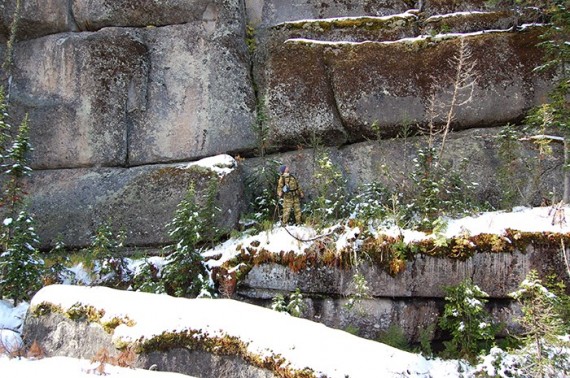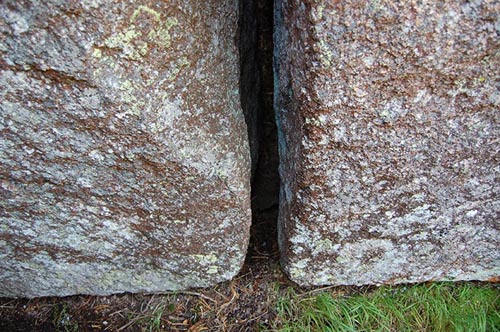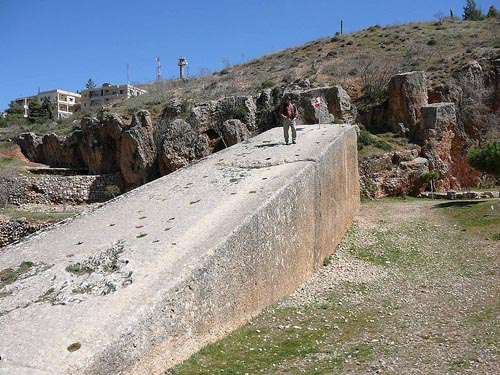Newly found megalithic stones are causing excitement in alternative history circles, and, depending on the research that continues to be done on this, history may require a rewrite.
This most astounding discovery of a wall of granite stones has been found in the south Siberian mountains (Mount Shoria), and photographs are coming out showing gigantic blocks of granite, some approximated to weigh more than 3,000 tons. They’re stacked neatly and precisely, 40 metres high, in what might be an unbelievable feat of human engineering. They look like a giant’s building blocks and completely dwarf the researchers on site.
Michael Snyder from TheTruthWins.com rightly points out the inconvenient truths that mainstream history and archaeology would have to deal with if these stones are found to be man made: "According to the commonly accepted version of history, it would be impossible for ancient humans with very limited technology to accomplish such a thing. Could it be possible that there is much more to the history of this planet than we are being taught?"
The findings are from archaeologist John Jensen (blog) at Academia.edu, and the images from Valery Uvarov’s Russian website.

For scale, note the man in center.

Straight edges, right angle forms.
Enormous megaliths and large stone structures can be found around the globe, some of the more well known being the still-mysterious "Stone of the Pregnant Woman" in Baalbek, Lebanon, and the "Thunderstone" in Saint Petersburg, Russia. To give a comparison to the heft of the 3,000 ton rocks in Siberia, the Baalbek unfinished monolith weighs 1,242 tons, and the Thunderstone is measured at 1,250 tons.

Ralph Ellis on the large stone at Baalbek, 2007, Wikimedia Commons

The pedestal under The Bronze Horseman is the Thunderstone, claimed to be the largest stone ever moved by man. It was moved 6 km overland for shipment, and cut from 1,500 tons to its current size during transport. Wikimedia Commons
There remains debate about whether the enormous Siberian slabs are megaliths created by the early hands of man and shifted into place with unknowable power, or if these are amazing yet recognizable examples of the natural process of erosion, realized as straight cracks and stacked stones.
Mysterious Universe reports on the various theories :
At the release of this story, some are excitedly claiming that the Shoria site is evidence of an ancient lost civilization; a civilization capable of incredible feats of engineering that even with our modern technology would be virtually impossible. Others though are wisely urging caution. The pictures are compelling, and the typical observer would be hard pressed to come up with a natural explanation, but there may be one.Read more at: mysteriousuniverse.org
In 1987 a group of recreational scuba divers stumbled onto another apparent super-megalithic site in Japan. The Yonaguni Monument, which sits off the coast of Yonaguni, which is the southern-most island of the Ryukyu Island chain, is considered by some to be the most compelling evidence for a lost civilization in our past. Others are less convinced, however.
Boston University geologist Robert Schoch believes that the features of Yonaguni are the result of natural geological processes. He cites well-defined parallel bedding planes and earthquake activity, and since there are similar formations in the region that are known to be completely natural, this seems a safe bet.
The Shoria site, however, isn’t in an area that’s prone to frequent earthquakes, and the stone involved is much harder than the sandstone of Yonaguni, but our weird world is known to have created some startling rock formations that defy explanation. [...]
It’s obvious more research must be done on this inspiring find.By Red Ice Creationshttp://www.davidicke.com/headlines/amazing-giant-megaliths-in-russia-natural-or-man-made/
Source: http://redicecreations.com/article.php?id=29326
Newly Found Megalithic Ruins In Russia Contain The Largest Blocks Of Stone Ever Discovered
An incredible discovery that was recently made in Russia threatens to shatter conventional theories about the history of the planet. On Mount Shoria in southern Siberia, researchers have found an absolutely massive wall of granite stones. Some of these gigantic granite stones are estimated to weigh more than 3,000 tons, and as you will see below, many of them were cut “with flat surfaces, right angles, and sharp corners”. Nothing of this magnitude has ever been discovered before. The largest stone found at the megalithic ruins at Baalbek, Lebanon is less than 1,500 tons. So how in the world did someone cut 3,000 ton granite stones with extreme precision, transport them up the side of a mountain and stack them 40 meters high? According to the commonly accepted version of history, it would be impossible for ancient humans with very limited technology to accomplish such a thing. Could it be possible that there is much more to the history of this planet than we are being taught?
For years, historians and archaeologists have absolutely marveled at the incredibly huge stones found at Baalbek. But some of these stones in Russia are reportedly more than twice the size. Needless to say, a lot of people are getting very excited about this discovery. The following comes from a Mysterious Universe article…
Alternate history buffs are about to be whipped into a frenzy! OK, maybe not, but they will find this interesting.An ancient “super-megalithic” site has been found in the Siberian Mountains. Found recently in Gornaya Shoria (Mount Shoria) in southern Siberia, this site consists of huge blocks of stone, which appear to be granite, with flat surfaces, right angles, and sharp corners. The blocks appear to be stacked, almost in the manner of cyclopean masonry, and well…they’re enormous!Russia is no stranger to ancient megalithic sites, like Arkaimor Russia’s Stonehenge, and the Manpupuner formation, just to name two, but the site at Shoria is unique in that, if it’s man-made, the blocks used are undoubtedly the largest ever worked by human hands.
When I say that this is a new discovery, I am not kidding. In fact, the very first expedition to study these stones happened just a few months ago. Prior to this expedition, there were no known photographs of these megalithic stones. Archaeologist John Jensen is mystified by these ancient ruins, and the following is an excerpt from a post on his personal blog…
The super megaliths were found and photographed for the first time by Georgy Sidorov on a recent expedition to the Southern Siberian mountains. The following images are from Valery Uvarov’s Russian website.There are no measurements given, but from the scale depicted by the human figures, these megaliths are much larger (as much as 2 to 3 times larger) than the largest known megaliths in the world. (Example: The Pregnant Woman Stone of Baalbek, Lebanon weighs in at approximately 1,260 ton). Some of these megaliths could easily weigh upwards of 3,000 to 4,000 tons.
Below, I have posted some of the images that he was referring to. As you can see, they are absolutely stunning…
Another very unusual thing about these stones is that they caused the compasses of the researchers to start behaving very strangely.
The following is an excerpt from a story on a Russian news source…
Some events that were happening during the autumn expedition could probably be called mystical. The compasses of the geologists behaved very strangely, for some unknown reason their arrows were deviating from the megaliths. What could this mean? All that was clear was that they came across an inexplicable phenomenon of the negative geomagnetic field. Could this be a remnant of ancient antigravity technologies?
Of course much more research needs to be done on this site.
Nobody knows who cut these stones or how old they are.
Jensen believes that they come from a time “well back into the mists of pre-history”…
These megaliths reach well back into the mists of pre-history, so far in fact, that conjecture about their ‘builders’, methods, purpose and meaning is pure speculation, and as such, I would hesitate to offer any observation at all, other than to say our pre-historical past is richer than we ever dreamed.
These stones are likely to remain an unsolved mystery for a very long time.
But what is abundantly clear is that according to the commonly accepted version of history they should not be there.
And of course this is far from the only site around the world that contains massive megalithic ruins. Perhaps the most famous are the megalithic ruins at Baalbek, Lebanon…
The following is some information about Baalbek from one of my previous articles…
The ancient city of Baalbek is one of the greatest archaeological mysteries of all time. Located east of the Litani River in the Bekaa Valley of Lebanon, Baalbek is world famous for its exquisitely detailed yet monumentally scaled Roman temple ruins. In Roman times, Baalbek was known as Heliopolis (after the sun god) and it contained some of the largest and most notable Roman temples ever built. In fact, the Romans had constructed an extraordinary temple complex in Baalbek consisting of three separate temples – one for Jupiter, one for Bacchus and one for Venus. But what these Roman temples were built on top of is much more important. These Roman temples were actually built on top of an ancient 5 million square foot platform that was made from some of the largest stones ever used in any construction project in the history of the earth. In fact, the largest stone found near the Baalbek ruins weighs approximately 1200 tons and is about 64 feet long. To put that in perspective, that is the equivalent of approximately 156 full size African elephants.How people in ancient times were able to move such massive stones is a complete mystery. In fact, these giant construction stones were stacked so closely together that you can’t even fit a piece of paper between many of them. Many of the architectural feats found at Baalbek cannot even be duplicated with 21st century technology.So how did they do it?How did they move such massive stones to create a structure of such intricate precision?Keep in mind that the base of the Baalbek ruins alone weighs approximately 5 billion tons.
Evidence continues to mount that very sophisticated technology was used in the ancient world.
These megalithic ruins are undeniable reminders of highly advanced ancient civilizations.
So who were they and what happened to them?
Could it be possible that they were wiped out by a massive global cataclysm such as a global flood?
Please feel free to share what you think by posting a comment below…
About the author: Michael T. Snyder is a former Washington D.C. attorney who now publishes The Truth. His new thriller entitled “The Beginning Of The End” is now available on Amazon.com.








Geen opmerkingen:
Een reactie posten